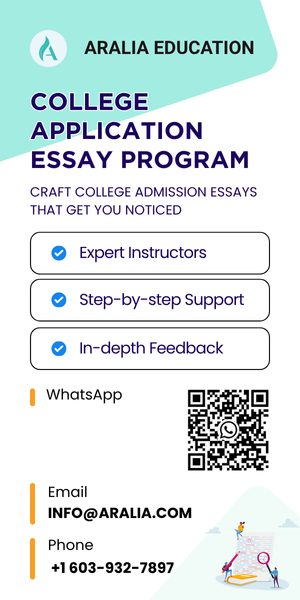85% of Aralia Students Place in Top Writing Competitions
1. What is a thesis statement?
A thesis statement is a research-backed, educated conclusion written after compiling sources that both support and oppose this conclusion. Generally, a thesis states a causal relationship between two scientific variables or historical events, etc. See below for examples of good thesis statements for high school research papers. A thesis statement also usually provides an outline for the argument in your paper so that readers know what to expect.
Can thesis statement be a question?
No, thesis statement can’t be a question. A thesis statement has to provide a clear and concise answer to the research requestion, presenting a claim that readers can evaluate based on the evidence and arguments in your paper. For example, instead of writing “Does standardized testing limit students’ creativity?” (a question), the better thesis statement should be “The U.S. education system’s reliance on standardized testing limits students’ creativity and critical thinking, highlighting the need for alternative methods of assessment”.
Can thesis statement be two sentences?
A thesis statement is preferably one sentence but consult your instructor if two sentences is acceptable. A single-sentence thesis is often more direct and easier for readers to grasp. However, for complex topics or arguments, using two sentences may be acceptable to clearly communicate the main idea and supporting details. For instance:
“The U.S. education system’s reliance on standardized testing limits students’ creativity and critical thinking. This paper will explore the negative impacts of standardized tests and propose alternative assessment methods to foster creativity.”
Before using two sentences, consult your instructor’s guidelines, as some may prefer or require a single-sentence thesis for clarity and precision.
2. Why do you need a thesis statement in your research paper?
Readers rely on your thesis statement to state the paper’s topic and claim what it’s arguing. A thesis statement not only clarifies a research paper’s direction, but also suggests the paper’s credibility. It’s crucial to conduct all your research before writing your thesis statement. Your thesis should not be a previous-held, biased opinion that you’re seeking evidence to prove. A productive, well-written thesis statement makes your paper sound thoroughly researched, detailed with credible sources, and insightful.
3. Where do you include your thesis statement in a research paper?
Your thesis statement is the last sentence of your introduction. The format of an introduction is as follows (disclaimer: this format may vary depending on your teacher’s requirements). The first sentence is a hook; consider using an interesting, unexpected statistic to simultaneously inform your reader of the topic of your paper and interest them in its importance and prevalence. Next, write the research question that your research paper is discussing and that your thesis statement answers. The following 3-5 sentences of your introduction are topic sentences of each of your body paragraphs. Each body paragraph should provide a different point serving as evidence to back your claim. Finally, your thesis concludes the introduction and serves as a concise, clear, conclusion to your research. This format—of providing evidence before the conclusion—makes your thesis appear credible, logical, and reasonable, therefore more persuasive.
4. Steps to write a compelling thesis statement
Writing a thesis statement includes conducting preliminary research, narrowing your topic scope, formulating a research question, conducting more specific research, and finalizing your claim as a conclusion to all your research. Follow these steps for how to write an eloquent, cohesive thesis statement for a high school research paper.
Step 1: Choose your topic
Before you start researching, make sure you choose a topic you’re truly interested in but don’t have a preexisting bias about, as to not cloud the objectivity and credibility of your thesis. Read how to start your research process.
Step 2: Do broad research
First, conduct background research on all arguments currently present in this research topic. Don’t rush to take a stance for your thesis. This step is primarily about learning as much as possible about the intricate, multiple facets of the topic. Search widely and note what specific niches in this topic you may be interested in diving deeper. Keep track of all your sources for your citations page.
Step 3: Narrow your topic
Once you’re finished with your preliminary research and have considered multiple supporting and opposing opinions, narrow down the scope of your research topic to be as specific and niche as possible (provided there is enough existing published research for you to cite). Begin developing a research question around your topic—this will be refined later on.
Step 4: Draft and answer your research question
Draft a sample thesis that answers your research question—here you begin to develop your educated opinion. Your claim must be provable, meaning it must be rooted in conclusions made from existing published research articles. Your thesis must be a theory that can be/has been proved or disproved in technical, realistic experiments. See below for examples of an unprovable thesis and other poor theses.
Step 5: Do specific research
Now that you have a clear direction, go back to conducting more specific research. Examine sources with arguments both supporting and disproving your claim. Edit your research question and answer as you gather more information. You can change your stance, and you should if you find more sources proving a different theory.
Step 6: Track your sources
Download Zotero and use the sticky notes feature to bullet main points from each of your sources. Another option is to make a notecard for each source, write main points, and physically arrange them into groups representing body paragraphs.
Step 7: Make your claim
Take a step back, look at all your research notes together, and finalize the overarching theme that your sources are supporting. Finalize this research-backed conclusion into a few sentences with a clear indication of which variables affect which effects.
Step 8: Turn it into a thesis statement
Condense your claim into 1-2 sentences to make a thesis statement. Your thesis should be concise, niche, and straightforward. Don’t try to tackle too broad of a scope. Phrase your thesis persuasively and with an interesting hook that invites readers to be curious about the evidence proving this opinion. Avoid writing a statement that is so plainly obvious and superficial that readers would be uninterested in hearing why you have come to this conclusion.
With your thesis, and throughout your paper, write objectively and stay open to research disproving your thesis. This leads to the last step of your research paper writing process. Conclude your research paper with acknowledgment of the opposing side to your thesis, and bring in a source to disprove it. Additionally, acknowledge the limitations of your thesis and suggest directions for future research.
Unlock Your Writing Potential: Students in Our Writing Competition Preparation Class Are More Likely to Secure Awards
5. Examples of thesis statements
A good thesis should be specific, provable, objective, and with clear direction. See below examples of good and bad thesis statements. With broad thesis statements, you may use them as guides to start broad, preliminary research and later narrow them down into more specific thesis statements.
Bad Thesis Statements:
“Obesity is a major problem in the U.S., pushing healthcare institutions nationwide to improve diagnostic criteria and treatment strategies.”
- This thesis doesn’t work because it states an obvious fact about obesity in the U.S., without providing any insight into which diagnostic criteria and treatment strategies are proving useful.
“World hunger has many causes and effects, negatively affecting the quality of life of children and adults across numerous countries.”
- This thesis tackles too broad of a topic, thus making the direction of the paper vague. A suggestion for improvement is to select a single country/town, limit to one age group, and state a specific cause and effect.
“Astrological signs predict human moods, suggesting necessary workforce schedule changes to accommodate maximum efficiency and employee wellbeing.”
- This thesis is unprovable and based in pseudoscience. While astronomy is a scientific field with solid evidence, astrology is not.
“Laissez faire economy never works, because government intervention is always necessary.”
- This thesis is too subjective. Avoid using extreme language such as “never” and “always.” This thesis can be improved by naming a country, government regime, and time period when laissez faire economy was deemed unsuccessful and government intervention was necessary.
“History provides vital lessons to assist us in navigating modern day foreign policy.”
- This thesis has no direction and can be improved by replacing “history” in general with a single historical event that had a ripple effect, guiding current world leaders in their decision-making. The improved thesis may name a specific modern-day foreign policy, and the paper may go on to prove how that policy was an unmistakable effect of the aforementioned rippling historical event.
Good Thesis Statements:
“This paper will discuss the U.S. education system’s reliance on standardized testing limits on students’ creativity and critical thinking, highlighting the need for alternative methods of assessment, and proposing alternative ideas to solve this issue.”
- This thesis has a narrow scope and clearly states the cause-and-effect variables that the paper will examine. Readers can expect this paper to cite sources with experiments yielding a negative effect of standardized tests on students’ creative growth.
“This paper will argue that the abolitionist movement in the 19th century was not only a moral campaign but also a powerful political force that reshaped American society and set the stage for the Civil War, citing examples that influenced this change and addressing counterarguments.”
- This thesis works because it suggests the author has done in-depth research on preexisting historical analysis of the American abolitionist movement and brings a deeper analysis to the field. This paper may bring in primary sources and provide a fresh perspective on their significance and impact as well as secondary resources analyzing the historical time period in an innovative fashion.
“This paper will address how exposure to nature through green spaces has been shown to reduce symptoms of ADHD in children, offering a promising, non-pharmaceutical approach to treatment, citing data and examples to support this point, as well as assessing counterarguments to this point.”
- This thesis is highly specific and provable, as it suggests the paper will provide a meta-analysis of multiple research studies on the causal relationship of two highly specific variables: green spaces and children with ADHD.









